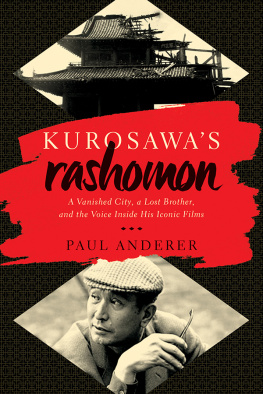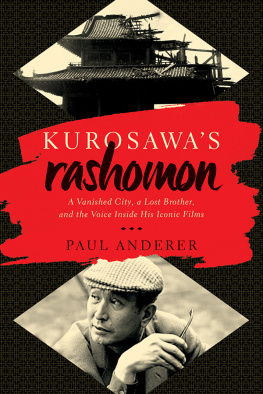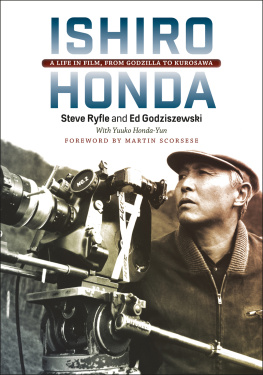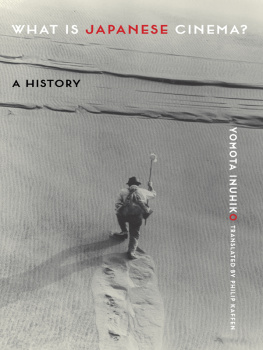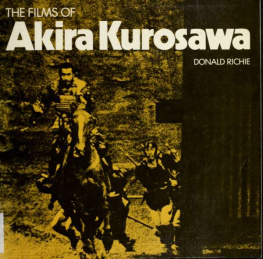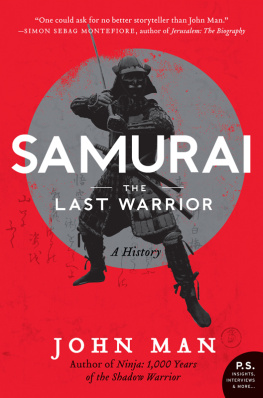

KUROSAWAS RASHOMON
Pegasus Books Ltd.
148 W 37th Street, 13th Floor
New York, NY 10018
Copyright 2016 by Paul Anderer
First Pegasus Books cloth edition October 2016
Interior design by Maria Fernandez
All rights reserved. No part of this book may be reproduced in whole or in part without
written permission from the publisher, except by reviewers who may quote brief excerpts
in connection with a review in a newspaper, magazine, or electronic publication; nor
may any part of this book be reproduced, stored in a retrieval system, or transmitted in
any form or by any means electronic, mechanical, photocopying, recording, or other,
without written permission from the publisher.
Library of Congress Cataloging-in-Publication Data is available.
ISBN: 978-1-68177-227-1
ISBN: 978-1-68177-277-6 (e-book)
Distributed by W. W. Norton & Company
For Mia
N ames appear in the Japanese order, last names first. Kurosawa standing alone always presumes Akira (I use the first names of his brother, sisters, mother, and father for clarity, and eschew macrons). Kurosawas memoir has been well rendered in English, as has Akutagawas fiction. In other cases, unless otherwise indicated, translations from the Japanese are my own.
At the end of the book, there is a simple timeline, should the reader wish a reminder about where Japanese era names fit, or where certain events mentioned in the text stand in relation to one another. This chronology, like the book, is weighted toward the modern period. It is especially detailed from the time of Kurosawas birth through to the making of Rashomon. Separately, there is a filmography, a roster of the thirty films Kurosawa directed between 1943 and 1993, although my story here focuses on the earlier, black-and-white productions. Under Further Reading, I note certain books that helped guide my thinking about Kurosawa or provoked me to look deeper into his life and work. They may prove to be of further interest to the reader.
I am neither a film scholar by training, nor a Kurosawa specialist in a traditional sense. This book does not presume to be a scholarly contribution to any distinct field. I wanted to write instead for a reader broadly interested in the culture of our time. I hold the view that Kurosawa is among our most powerful tellers of stories over the last hundred years, in literature or in film. And inside his greatest stories, I came to believe, there was another tale that regularly circled around certain domestic or city scenes Kurosawa grew up with, many of which would vanish, tragically, from view. There was a brother, too, whose voice I kept hearing, and whose shadow presence came to loom large in my account.
Much of the book was blocked out, and drafts of many chapters written, during a year of sabbatical leave spent between Tokyo and Rome. At Waseda University, the media scholar Toeda Hirokazu was a gracious host, as was Mathilde Mastrangelo at La Sapienza. In these two great, roiling cities, the sites of ruins widely separated in time, I found quiet corners to work, fueled by green tea or espresso as available and needed.
On other research trips to Tokyo of shorter duration, I was always generously assisted by the devoted staff at Wasedas Empaku Library. At the National Film Center in Kyobashi, Irie Yoshiro and Okada Hidenori (and through the latter, Makita Toshifumi) provided expert guidance. To aid my research in Tokyo, or with materials gathered there, I further benefited from the dedicated efforts of Takeda Tatsuya and Mana Karimata.
Friends and colleagues have listened to me lecture or just talk about this book for many years now, or have subsequently read one or another draft chapter, with responses that often surprised me in the right, corrective ways. It is not hard to reckon my debt to: Stefan Andriopoulos, Giorgio Biancorosso, Jim Cheng, Jonathan Cole, Marty Gross, Chris Hill, Hikari Hori, Andreas Huyssen, Kataoka Ichiro, Ken Ito, Karatani Kojin, Philip Kitcher, Sumio and Ikuko Kusaka, Indra Levy, Seiji Lippit, Lydia Liu, David Lurie, Edward Mendelson, Mizuta Noriko, Nogami Teruyo, Ohwada Toshiyuki, Kyoko Omori, Richard Pena, Jonathan Reynolds, the late Donald Richie, Bruce Robbins, Sato Tadao, James Schamus, Wei Shang, the brothers James and Michael Shapiro, Tanami Tatsuya, Watanabe Naomi, and Jonathan Zwicker.
I have been blessed over my career on Morningside Heights to work with extraordinary Columbia and Barnard students. In successive Kurosawa seminars, begun long before this book was conceived, my students moved me, by their intellectual daring and insights, to gather and better understand my own thoughts about Kurosawa. I trust they recall our discussions and will recognize their imprint here.
I owe a special debt to three others who have passed on. Lewis Cole, who taught screenwriting at Columbia, was diagnosed with ALS around the time I first imagined a Kurosawa book, one with a backstory about an older brother. Even as he was failing, Lewis stood tall, an unflinching interlocutor and friend. He gave me the crucial impetus to write in the first place. So too did Arthur Danto, a friend of many years, whose profound explorations of modern art and life, and whose response to an early talk I gave at the Society of Fellows, were a further sustaining encouragement. Robert Belknap, the revered teacher and Dostoevsky scholar, invited me to give the Tannenbaum Lecture at the University Seminars, and responded to what I said that night with characteristic incisiveness, wit, and grace.
Yomota Inuhikos work on film and modern culture, East and West, has been a steady source of inspiration over the years. He is also a great walker through many cities, and once guided me though a warren of side streets in Kagurazaka, toward the likeliest spot where Kurosawas brother lived the last years of his life. On another excursion in driving rain, we trudged up a steep incline to the location of that house perched high on a hill in High and Lowa modernist castle overlooking Yokohama (the house was long gone, replaced by a thriving middle school). The novelist Shimada Masahiko, equally steeped in Tokyo and in New York life, as well as in Russian literature and opera, has followed this story from act to act, and offered generous advice along the way.
I have further relied on Tomi Suzuki, for her authoritative understanding of how personal narratives work in modern Japanese letters, and for her abiding support and friendship. To Haruo Shirane, whom I helped recruit to Columbia and who is now chair of our department, I offer sincere thanks for giving me valuable time to bring this manuscript to a close. Joanne Bernardi and Kerim Yasar, both deeply knowledgeable about how sound works in early Japanese cinema, provided crucial checks and readings in the final stages.
For their technical expertise in locating or better framing the books visuals, I benefited from the timely help of Gabriel Rodriquez, Emily Shaw, and Michael Belantara. I wish to thank Charles Brock for his cover art and Maria Fernandez for her design of the books interior.
Michael Carlisle, my agent and friend, has been unwavering in his commitment and steely belief that I would write this book. My publisher at Pegasus, Jessica Case, has been keen-eyed, creative, and utterly supportive at every step, helping me draw out lines of connection between the moving parts. Lori Paximadis edited the manuscript with extraordinary care and insight.
Finishing a book, as I did, over a long summer in the city of New York, it helped to have family around, and sons who can all cook. In Brooklyn backyard barbeques, or at Manhattan restaurants run by Anderers, I savored our weekly meals, for the welcome respite from my labors, the great tastes, and the even sweeter company.
Next page
